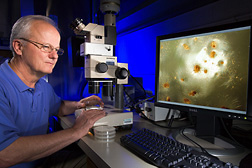This page has been archived and is being provided for reference purposes only. The page is no longer being updated, and therefore, links on the page may be invalid.
Read the magazine story to find out more. |
|
|
New Fungal Finding Could Mean Better Bio-Insecticide
By Jan SuszkiwSeptember 4, 2008
A method of culturing the beneficial fungus Metarhizium anisopliae so that it churns out billions of tightly bundled cells, called "microsclerotia," could mean even more moldy mayhem for soft-bodied ticks, termites and crop pests including sugar beet root maggots.
Until 2004, Metarhizium wasn't known to produce the microsclerotia--among the toughest forms this fungus can take to tolerate adverse conditions. Indeed, only plant-disease fungi were thought to produce these sturdy cells. But now that the "secret" is out, Agricultural Research Service (ARS) scientists aim to exploit the information to develop new, improved bio-insecticide formulations containing the fungus.
For more than a decade, bio-insecticide makers have formulated Metarhizium using conidia or other spore forms. But mass-producing them has been time-consuming and labor-intensive. Conidia-based formulations have also suffered from poor shelf life and field survival once applied, according to microbiologist Mark Jackson. He works at the ARS National Center for Agricultural Utilization Research in Peoria, Ill.
Jackson's studies with ARS entomologist Stefan Jaronksi show that using microsclerotia instead of conidia can cut the costs and time involved in formulating the fungus and can significantly improve its shelf life and pest-fighting performance.
For example, in studies led by Jaronski at the ARS Pest Management Research Unit in Sidney, Mont., conidia-only granules of Metarhizium germinated seven to 10 days after being applied, versus four days with microsclerotia-based formulations. The scientists were also able to produce the microsclerotia in four days, compared to two weeks for conidia. And during 2007 field trials, sugar beet root maggots inflicted far less feeding damage to microsclerotia-treated beets than to ones treated only with conidia.
Another advantage, according to Jaronski, is that the microsclerotia can be formulated into granules and sized more easily than other spore forms. This should make the microsclerotia more compatible with farmers' seed planters and pesticide granulate applicators.
The fungus infects and kills only certain insect hosts, and is never harmful to people, pets or livestock.
Read more about this research in the September 2008 issue of Agricultural Research magazine.
ARS is a scientific research agency of the U.S. Department of Agriculture.

